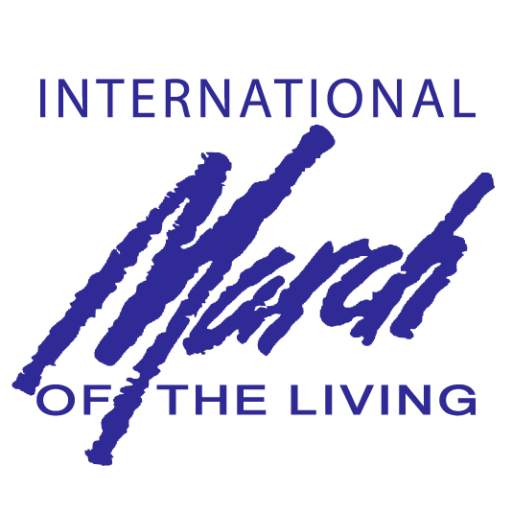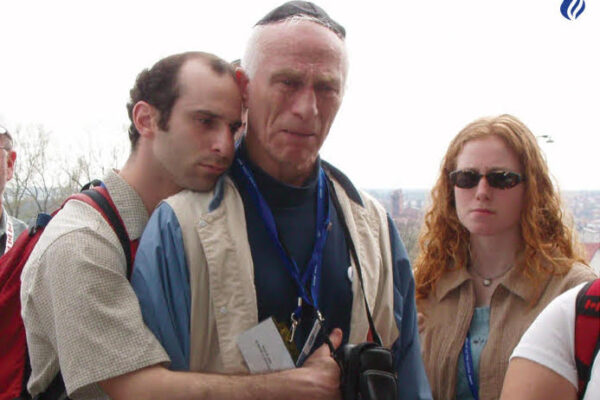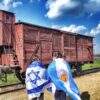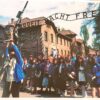It may be a good thing Joshua Zimmerman didn’t start researching his book “The Polish Underground and the Jews, 1939-1945” now. Even without the recent victory of right-wing Law and Justice party, with its nationalist platform and call to culturally whitewash Poland’s Holocaust past, documenting the true relationship between Polish partisans and Jews was a daunting task.
With anti-Semitic sentiment resurfacing in Poland, the climate isn’t exactly conducive to mining the great divide. At least one right wing politician has openly blamed Jews for instigating two weekends of civil protests over Law and Justice’s stranglehold over both the presidency and parliament. The demonstrations aren’t about to subside any time soon. Lech Wałesa, the leader of the Solidarity movement in the 1980s, spoke out Wednesday against a new law that would virtually eliminate the court as a check on government power.
As Poland becomes increasingly polarized, Jews are caught in the crosshairs. As a response to the Paris attacks last month, a group in the city of Wroclaw protesting the European Union’s call to absorb Syrian refugees burned an effigy of a Hassidic Jew holding an EU flag, chanting: “God, honor and fatherland!”
In Poland, Jews are sometimes conflated with Muslims. At other times, they’re not. Last Sunday, Jewish graves in the city of Sochaczew were vandalized with pro-ISIS graffiti, complete with swastikas and slogans like “F**k the Jews” and “The Holocaust never happened.”
To add fuel to the fire, Poland’s new culture minister Piotr Glinski, in an interview with Reuters last week, spoke of his plans to rehabilitate Poland’s image through a Hollywood blockbuster along the lines of “Braveheart” or “Pearl Harbor,” because such films would enable Poland to “build its strength and to win, or rather, not to lose, on the world stage.”
As for last year’s Oscar winner, “Ida,” a film about post-war Polish identity and the guilt of villagers in the murder of a Jewish family, Glinski denounced it, adding, “it is disturbing that Poland is ascribed fault [in the Holocaust].”
And don’t even mention the town of Jedwabne, the site of a bloody pogrom in 1941 that the Poles blamed solely on the Nazis. Two years earlier, the Polish film “Aftermath,” about the Jedwabne controversy and the topic of the recently published “The Crime and the Silence” by Anna Bikont, resulted in death threats to the film’s star. The largest Polish news weekly, Wprost, featured his defaced portrait on the cover with a Jewish star and the word “Zyd” (“Jew”) scrawled around his head in the style of anti-Semitic graffiti found in Poland.
Debate about Poland’s complicity in exterminating its Jews seems like it may be curtailed further. Polish-born Princeton professor Jan T. Gross, author of “Neighbors: The Destruction of the Jewish Community in Jedwabne,” the first book addressing Polish guilt for the pogrom, is being threatened with a libel suit for an editorial he wrote in German newspaper Die Welt, in which he claimed that Poles killed more Jews than they did Germans during World War II.
Though the newly elected government seems to be invested in only one narrative concerning Poland’s wartime past, some don’t see the related anti-Semitic activity as anything new.
“First of all, there is no ‘latest wave,’” says Konstanty Gebert, a Warsaw-based journalist for Gazeta Wyborcza, a Polish Jewish activist and author of “Living in the Land of Ashes.” “It’s the same old anti-Semitism, given more prominence by the fact that its supporters are now part of the victorious political camp. There will be some more of it, in Hungarian style, but it is not an autonomous feature. Rather, attitudes toward Jews are an indicator of broader positions on the democracy/authoritarianism divide.”
And most see the subject of the partisans’ relationship to Jews as part of that fault line.
“It’s a taboo topic. Many of the pogroms were carried out by partisans who are considered national heroes here,” says Zuzanna Radzick, a board member of Forum for Dialogue, the largest Polish nongovernmental organization dedicated to Jewish-Polish reconciliation through various initiatives. “The next big discussion in this country will be about the underground.”
In many ways, the new government’s ability — or inability — to examine this fraught history will be a good predictor of anti-Semitic attitudes moving forward, and whether all the bridge-building efforts by Forum and other organizations, such as the Auschwitz Jewish Center’s Understanding Evil program, which trains police officers to respond to hate crimes from swastika graffiti to worse, will suffer setbacks.
“The government’s failure to denounce [recent anti-Semitic slurs] is indeed source for concern,” says Gebert. And it makes Zimmerman’s tome on the Polish Underground all the more pressing. The comprehensive 400-page book paints a nuanced look at the Underground’s roots and various factions — good, bad and ugly. It highlights the heroism of many partisans who risked their lives to save Jews, while also indicting figures wrongly beatified in Poland.
And that’s exactly why Zimmerman knows the road to having his book accepted in Poland may be a long one.
“In Poland, to imply that partisans could be war criminals is heresy,” says Zimmerman, the chair of Holocaust studies and East European Jewish history at Yeshiva University in New York, echoing Radzik’s sentiments. “To Poles, they’re part of ‘sacred national memory,’ to quote Eva Hoffman, the famous Polish Jewish writer. These are heroes to them. They perished fighting the Nazis. It’s sort of like suggesting the IDF doesn’t always act morally or ethically to an Israeli. The Polish Underground is a symbol of martyrdom and resistance and the struggle for the defeat of Nazi Germany along with the Western allies for the freedom of Poland and Europe as a whole.”
Conversely, he found, most Holocaust survivors view the Polish underground as not only anti-Semitic but complicit in the genocide of European Jews. The great gap in perception is wide even among Polish and Jewish scholars, Zimmerman says.
A survey conducted by POLIN, the Journal of Polish Jewish Studies, asked Polish American and Jewish American academics whether the Polish Home Army favored equal rights for the Jews. Eighty-eight percent of Polish American academics responded yes, while eight percent of Jewish academics agreed.
“That huge difference told me there was something there to investigate,” says Zimmerman, who got the idea for the book after reading the obituary of Cyla Mueller, Simon Wiesenthal’s wife.
“It mentioned she was saved by the Polish underground,” he says. “After reading countless survivor testimonies, I thought, what was this underground group that saved her? Maybe there’s something more to this story.”
And it took someone as bias-free and well researched as Zimmerman, who authored two previous books on Polish Jewish history, “Poles, Jews and the Politics of Nationality” and “Contested Memories: Poles and Jews during the Holocaust and its Aftermath,” to undertake such an audacious task.
“I dedicated my book to my wife’s mother who died before I met her, but who was a survivor and raised my wife to think that Poles are the most anti-Semitic people,” says Zimmerman. “I’m a third generation American, and my ancestors emigrated before World War I. When I learned about the Holocaust, the Poles weren’t really a part of the picture, only the Germans, which helped me be a bit more objective.”
His neutrality, painstaking dedication and fluency in Polish helped him sift through the various cobwebs of perception on both sides and gain access to files others would never have found. He conducted his detective-like search for the truth in four countries — the United States, Poland, Israel and England, where the Polish Home Army had been exiled and where their archives are stored.
What he discovered surprised him.
“I went to the national library in Warsaw to find any Jewish communication between local and central Polish resistance, but was coming up dry,” he says. “Then two hours later, the archivist comes to me and says, ‘there’s an archivist in the back who wants to talk to you.’ She asked, ‘have you heard of this manuscript by Stanislaw Aronson?’” It had been typed in English and read “Poland-War Years, 1944-45,” filed from Tel Aviv in 1988.
The author, Joshua D. Zimmerman, chair of Holocaust studies and East European Jewish history at Yeshiva University in New York, 2015.Anna Gross
Three months later, Zimmerman was in Aronson’s living room hearing his remarkable story of fleeing the Warsaw Ghetto and meeting a member of the underground who recruited him while Aronson was in hiding.
“He had a unique view during the Warsaw Uprising and talks about being a Jew in the Home Army, adopting a pseudonym, but he told his comrades that he was Jewish, and claimed he never once experienced the slightest bit of anti-Semitic innuendo,” says Zimmerman. “But he wasn’t the only one. There was also Stanislaw Likiernik, who I was also able to locate and who gave me a different perspective. They were in the same general unit, but their experiences were different. And that’s what I needed to do—uncover as many of these narratives as I could and lay them out and really see what local attitudes were regarding Jews.”
What he discovered is that they greatly differed depending on location, unit and person. Sometimes when going through officers’ reports, Zimmerman would see a word that alerted him that perhaps the author’s attitude was different than the norm.
“I would see, ‘Unfortunately, most people here are happy to see that Jews are gone,’” Zimmerman notes. “So you could tell that the person writing the report wasn’t an anti-Semite.”
He also had to look at the dates of the testimonies to see whether witnesses may have distorted the information to reflect popular opinion, and take all these factors into account. “A testimony filed right after the war may be more accurate than one given decades later, like when the Shoah Foundation started archiving survivor testimonies in the 1990s, because we remember less as time goes on,” he says. “But sometimes time worked in favor of the truth.”
In other words, there’s a reason why many of these testimonies started to emerge only in the past 15 years. Perhaps he wouldn’t have been able to start writing his book now, but he also couldn’t have written it 20 years ago.
“What I learned from Stan Aronson was that he and others weren’t comfortable telling their stories until around 2000 because he felt he would have been persecuted by his peers,” Zimmerman says. “When Poland established diplomatic relations with Israel, then it was okay to air a story full of warm feelings for Poland.”
And the converse was true in Poland. With the dismantling of the Communist regime came a desire to unearth Poland’s Jewish past and stories of Polish Jewish solidarity that had been verboten.
The last klezmer of Poland, Leopold Kozlowski, was from a Krakow underground unit that consisted of a Jewish platoon in the Home Army. “I met him through Lucyna Les of the Jarden Bookstore in Krakow,” says Zimmerman. “He goes to the Klezmer Hois in Kazimierz everyday at noon, has a coffee and plays in the orchestra. And his story is a complete negation of the collective memory of the Polish Underground being endemically anti-Semitic.”
The Jewish Platoon that Kozlowski and his brother Adolf served in helped rescue the Jews of Hanaczow when the Ukranians, aided by the Germans, set fire to homes to ferret out hidden Jews. The platoon and the Home Army safely transferred the Jewish population to the nearby village of Bilki in April 1944. One of those evacuees was Selma Horowitz, whom Zimmerman met while attending a dinner for the American Society of Friends of Yad Vashem in Long Island.
“It was a fateful encounter,” Zimmerman says of meeting Horowitz, who told him of how Kozlowski’s platoon and the Home Army rescued 250 other Jews from her village.
But not all chapters paint as glowing a picture of Poles. Chapter 10 takes a very critical look at those Home Army commanders who committed real crimes against humanity. Their accounts are shocking and disturbing, told in graphic detail, attesting to how easily it was to turn entire units against Jews, even among those who weren’t openly anti-Semitic before the war. “They were all too eager to kill entire villages of Jews out of some misplaced sense of fulfilling a moral obligation to rid Poland of Jews,” says Zimmerman. “Many called Jews worse than Nazis. And yet, at the same time, in a different region, there are Jewish platoons fighting alongside Polish ones.”
In other words, there was great variation among the units.
Still, Zimmerman isn’t expecting the new Polish government to heed the negative stories and do something to correct the national narrative. For example, when he was investigating how the Polish Home Army turned its guns on the Jews of Byalistok, he came across the testimony of Col. Liniarski, who bragged with glee about how many Jews he had killed. He also discovered there’s a church in Warsaw that bears a plaque in his name.
“Will they admit this is someone not to honor?” asks Zimmerman. “The evidence has been out there for 10 years, and there’s no action to remove the plaque.”
And yet, Poland’s last president, Bronislaw Komorowski, wrote a letter to Zimmerman and provided a footnote for his book to the story of how Komorowski’s uncle was nearly rescued by a Jewish member of the Home Army called Eliasz Baran. The attempt failed and both ultimately died in the war. But the would-be rescuer’s son, Ze’ev Baran, survived and serves as honorary consul of the republic of Poland in Jerusalem.
Does Zimmerman think these stories will help foster Polish-Jewish reconciliation or will the government reject the book whole and turn back the clock on efforts toward remembrance and cooperation?
“I think they might like it because it does promote stories of the likes of Jan Karski and Irena Sendler, who are still largely unknown outside of Poland,” says the Yeshiva University professor. “But if they’re not receptive to stories like Jedwabne, then they will reject it, because I present a balanced view.”
And how will survivors and the Jewish community take to it? Zimmerman’s wife said she didn’t think her mother would have liked it. Those who survived pogroms by the Underground may have a hard time warming to it. But that’s precisely why both sides need to read it.
“We’re a healthy democracy because we acknowledge past wrongs and don’t try to deny them,” he says. “The fact that the former Polish government supported POLIN, the Museum of the History of Polish Jews, in Warsaw, investing millions of dollars into it, is a positive sign. I can’t speak for the new government. But what my books show is that a Jewish American can look honestly and come to a reasoned study of this controversial issue, and that there are several sides of this story. And hopefully, it will move them to do so, too.”
But Gebert, who knows full well the obstacles ahead, may have a more realistic view.“The merit of the book is to show how complex the attitudes of the underground towards Jews were,” he says. “No such monograph exists in Polish; it would be very useful if the book would be translated. Having said that, it would in no way impact public debate.”
Please follow Marisa on Twitter @marisafox
By Marisa Fox-Bevilacqua
Original article published HERE.








